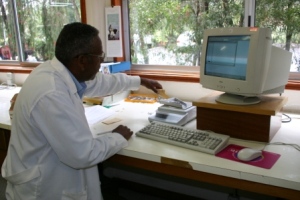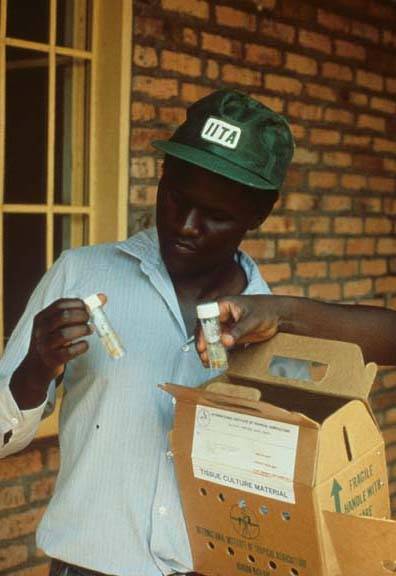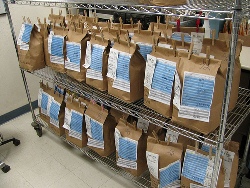Distribution
.jpg) View the full chapter on distribution by clicking on the icon above. (0.1 MB) |
Page compiled by: Bioversity International/ILRI, Addis Ababa, Ethiopia (Alexandra Jorge); ILRI, Addis Ababa, Ethiopia (Jean Hanson) including information extracted from: Rao NK, Hanson J, Dulloo ME, Ghosh K, Nowel D and Larinde M. 2006. Manual of seed handling in genebanks. Handbooks for Genebanks No. 8. Bioversity International, Rome, Italy. 147pp.
What is germplasm dissemination
Germplasm distribution is the supply of representative samples of seeds or plant material accessions from a genebank in response to requests from germplasm users. In general, seeds or plant material is only distributed from active collections.
|
Preparing samples for dissemination (photo: ILRI) |
|
Dissemination of vegetatively propagated material (photo: IITA) |
|
Accessions ready to be shipped at the USDA genebank (photo: L. Guarino, by kind permission of USDA genebank in Ames, Iowa, USA) |
Why is germplasm distributed
The purpose of conserving germplasm in a genebank is to make it available for use by current and future generations, usually to improve crop varieties through plant breeding to meet the needs of farmers and communities, for research activities or to restore diversity lost on farm and in natural habitats. Genebanks can be more proactive in establishing links with germplasm users, breeders, researchers, farmers and other groups to enhance the use of the germplasm.
Legal considerations for distribution
Access to genetic resources for distribution is guided by international law, specifically the Convention on Biological Diversity and the International Treaty on Plant Genetic Resources for Food and Agriculture (Treaty), and is tied to sharing any benefits from the use of the material. Germplasm is usually distributed under a Material Transfer Agreement (MTA) that sets out the terms and conditions of access and responsibilities of recipients.
In the case of crop germplasm, the Treaty establishes a global system to provide farmers, plant breeders and scientists with no-cost, facilitated access to plant genetic material. It also ensures that users share any benefits they derive from genetic material used in plant breeding or biotechnology with the regions from which they originated. It recognizes a set of crops in Annex 1 of the Treaty with mutual dependence among countries and establishes a multilateral system for their conservation and use, using a standard Material Transfer Agreement setting out the terms of access and benefit sharing.
Several genebanks, including those of the International Agricultural Research Institutes, signed an agreement with the Governing Body of the Treaty placing their in-trust collections of Plant Genetic Resources for Food and Agriculture (PGRFA) within the purview of the Treaty. In accordance with this Agreement, all shipments of PGRFA of crops listed in Annex 1 to the Treaty (shipments of PGRFA under the Multilateral System) will be subject to the terms and conditions of the Standard Material Transfer Agreement (SMTA). In the event that the SMTA is used for the transfer of PGRFA other than those listed in Annex 1 of the Treaty:
-
i) The references in the SMTA to the "Multilateral System" shall not be interpreted as limiting the application of the SMTA to Annex 1 Plant Genetic Resources for Food and Agriculture, and in the case of Article 6.2 of the SMTA shall mean "under this Agreement".
-
ii) The reference in Article 6.11 and Annex 3 of the SMTA to "Plant Genetic Resources for Food and Agriculture belonging to the same crop, as set out in Annex 1 to the Treaty" shall be taken to mean "Plant Genetic Resources for Food and Agriculture belonging to the same crop".
The SMTA allows the recipient to utilize and conserve the material for research, breeding and training and distribute it to other parties provided such parties accept the terms and conditions of the SMTA and also to agree to a system of benefit sharing from any commercial use of the germplasm.
Those genebanks from countries which have signed the Treaty or have signed an agreement with the Governing Body of the Treaty will require recipients to agree to the terms of access under the SMTA before any germplasm can be distributed and will provide documents with the germplasm to clarify the conditions for its use.
How should germplasm be distributed
Germplasm should be distributed in a way that ensures it reaches its destination in good condition. Environmental conditions during transport can be detrimental to seed or plant material quality and viability, so seeds or plant material should be carefully packed and distributed in adequate containers for protection during transit using the most direct and fastest route. Mail or courier services with a tracking system are very useful to follow the package to its destination.
The scope and extent of distribution varies with each genebank. Germplasm may be distributed within or outside the country, depending on the genebank’s mandate and whether its collection is national, regional or global.
Dissemination of germplasm in detailed steps
Click here to open a PDF document that shows how to disseminate germplasm in detailed steps.
References and further reading
Rao NK, Hanson J, Dulloo ME, Ghosh K, Nowel D, Larinde M. 2006. Manual of seed handling in genebanks. Handbooks for Genebanks No. 8. Bioversity International, Rome, Italy. Available in English (1.5 MB), Spanish (1.4 MB) and French (1.9 MB).



 Distribution
Distribution



Leave your comments
Post comment as a guest